

|
index
rouen
cathedral illustrated
rouen
cathedral
rouen, 1908
the window of st julian the hospitalier
rouen cathedral plan and dimensions
note from abelard
background facts
end notes
“ From the end of June to mid-September, every evening at nightfall
the cathedral square is to become a theatre of light. In a highly original
creation, the façade of the monument will be transformed into
a huge painter's canvas, where colours inspired by Claude Monet's famous
cathedral series will be projected. The City of Rouen and its Heritage
and Tourism department are behind this initiative involving a National
Monument.”
[From July to mid September.]
Painting with lights is becoming a popular spectacle in France. Poitiers
Cathedral was a previous subject for such show, demonstrating how medieval
craftsmen painted the statues on the cathedral main façade. The
colours have since worn away through the centuries. It is only a modern
fashion to have bland, naked stone inside and outside Christianist ritual
buildings.
The show at Rouen has a large easel set up outside the cathedral on which
a dozen of Monet’s paintings are projected in synchronisation with
the changing lightshow.
rouen
cathedral
Despite being painted about thirty times by Claude Monet in various light
and weather conditions, Rouen is not one of the very most spectacular
French cathedrals, but it is well worth a visit, especially since a large
amount of the stonework has been restored. Five thirteenth-century stained
glass windows have survived foreign invaders and the depredations of time.
 |
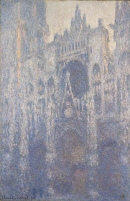 |
 |
| Rouen cathedral in evening light |
Rouen cathedral in morning light |
Rouen Cathedral by Claude Monet |
You may find two excellent photographs, one showing Rouen
Cathedral and its siting in the town and surroundings. (There is an
accompanying potted history, which is coloured by the site-owner’s
personal hobby.) The other shows the Nave
of Rouen Cathedral, with detailed description of the cathedral’s
interior architecture.
Rouen cathedral is one of the great structures
of France, but was greatly damaged
during the second World War. It has been heavily restored since then.
A great deal of damage was done during the invasion, but fortunately
much of Rouen’s glass had been removed to safety. Three other Rouen
churches with important sixteenth century glass were St. Godard, St. Vincent
and St. Patrice. The building of St. Vincent was smashed beyond recovery,
but its glass may now be seen in the extremely modern, boat-like new church
of Ste Jeanne d’Arc. Of course, Rouen was involved in the disgraceful
martyrdom of Joan of Arc (1412 - 1431).
Rouen is situated on the Seine, 82 miles/130 km northwest of Paris, and
about 55 miles/88 km from Le Havre on the coast, at the mouth of the Seine.
The old city, situated on the right bank, has been called Ville-musée (museum town) in view of its great many ancient buildings.
I am using the city of Rouen as the first cathedral town in this series
of documents of stained glass and cathedral architecture. While the stained
glass in the cathedral is not among the best collection in France, Rouen
has a great variety of churches with glass from several eras and much
other interesting history. Some may find a day or two visiting this ville-musée a good introduction and orientation before submitting to the shock and
awe of visiting the
top sites.
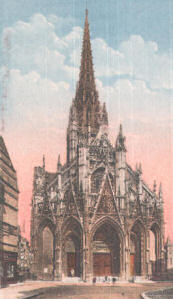 |
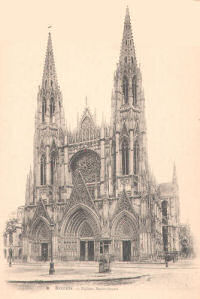 |
Saint Maclou
Church, Rouen
note the rare five-aisle construction [1] |
Saint Ouen Church,
Rouen |
 rouen,
1908 rouen,
1908
“Upon approaching Rouen one is sure to be struck by the insolent
daring of its situation. Lying on a sloping plain beside the river,
it seems to disdain the well-nigh impregnable site afforded by the steep
cliffs which rise just to the northeast. The history of the city bears
out the audacity of its location. Through all the centuries its inhabitants
concerned themselves so continuously in conquering other peoples that
little time was left in which to consider the security of their own
homes.” [p;249]
—
“Perhaps the most characteristic feature of Rouen when viewed
from a distance is the great number of its spires that shoot up above
the housetops, earning for it the sobriquet of the City of Churches.”
[p.250]
Quoted from Stained Glass Tours in France by Charles Hitchcock
Sherrill, John Lane Company, 1908.
left: one of the five remaining 13th century windows,
in the ambulatory of Rouen cathedral. |
|


key to the story panes in the St Julian the Hospitaller window
|
the
story window of st julian the hospitaller
In jewel-like blues and reds, this early 13th-century stained-glass window
in Rouen cathedral tells the tragic story of St Julian, who accidentally
murdered his parents and founded a hospital in penance.
Like a comic strip, the stained glass window - made in about 1220-1230
when the ambulatory was finished - tells the story of Julian the Hospitaller.
As with all medieval stained glass windows, this windows reads from the
bottom to the top: as you look upwards the glass is more luminous, most
of all when that look approaches the last quadrilobe that shows Heaven.
“[...] The nineteenth-century novelist Gustave
Flaubert, who saw the Rouen window, was inspired by the narrative
embedded in its thirty panels to create his own fictional
representation of Saint Julian, which he published in 1877 in the
volume Trois Contes. The iconographic tradition, represented in paintings,
miniatures, sculpture, and tapestry, as well as in stained glass, makes
clear the legend's most memorable features. Julian himself is usually
portrayed as a hunter with a sword at his side and a falcon in his hand,
reminding the viewer that the prophecy of murder occurred during the
course of a deer hunt. Of the two scenes most frequently depicted, the
first shows Julian in the act of killing his parents and the second
has him carrying the leper across the river to the hospice maintained
by Julian and his wife.”
—
“That Flaubert saw the window in his native city of Rouen is certain.
Teasing out his relationship to and use of the other source materials
which he may have utilized for his highly imaginative transformation
of the legend is less easy. It is known that he read his friend Langlois'
account of the Julian window, as well as a French translation of LA
[Legend Aurea by Jacobus de Voragine], but there has been considerable
disagreement as to whether he actually read (or was capable of reading)
a manuscript of the thirteenth-century French prose life, which he may
have come across during a visit to the Bibliothèque Nationale
in 1875 at a time when he was having difficulty with the writing of
his own Julian tale. The reader who is interested in this puzzle about
the relationship of a great nineteenth-century novelist to the Middle
Ages, as well as in the heated opinions of those who have tried to trace
the path of his inspiration, may find a detailed and scholarly discussion
in Bart and Cook, Legendary Sources, pp. 29-93. A recent English translation
of Flaubert's Trois Contes is Three Tales, trans. Krailsheimer. ”
[Quoted from libr.rochester.edu]
Flaubert was inspired by drawing of Espérance Langlois made in
1832 which is included in the book Essay on painting, written
by Hyacinthe Langois.
For
a pane-by-pane analysis of the story window of Julian the Hospitaller.
rouen
cathedral plan and dimensions
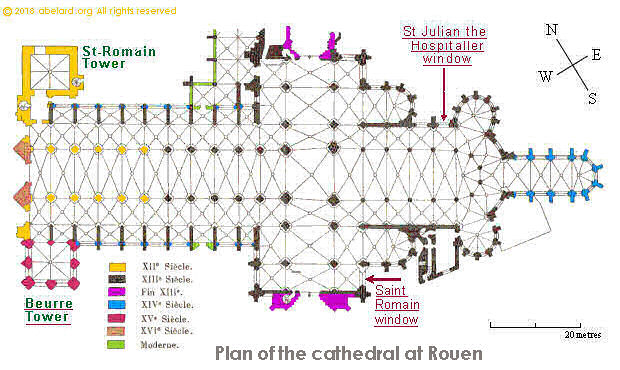
Interior floor and window plan of Rouen Cathedral
lengths:
- interior length: 136.86 m
- exterior length: 144 m
- transept exterior: 57 m
- transept interior: 53.65 m
- nave: 60 m
- choir: 34.30 m

widths:
- western façade: 61.60 m
- nave: 24.20 m
- central aisle:11.30 m
- transept: 24.60 m
- choir: 12.68 m
heights:
- tower Saint-Romain: 82 m
- tower Beurre: 75 m
- transept tower: 51 m
- central spire, above transept tower,
total height: 151 m
- northern transept arm: 28 m
- southern transept arm: 28 m
- central aisle vaulting: 28 m
- side aisle vaulting:14 m
- choir: 28 m
weight:
- central spire weight: 600 tonnes
For more on
naming the parts of a cathedral, as well as information on cathedral construction.
note from
abelard
This page is the first of a series, planned mainly around my interest
in stained glass. This series is not designed
for comprehensive information on the history and architecture of these
great buildings. Sketches of such data can be found in the Michelin
Green Guides, and more depth in a multitude of sources.
As with France section in general, my intention is to give you my own
idiosyncratic view of these places. As you will know from elsewhere, I
am no fan of noisy, smelly cities and I tend to go into these towns primarily
to observe the stained glass.
In the 12th and 13th centuries, when the most magnificent
of these structures were assembled, it has been calculated
that approximately one-third of the gross national product
(GNP) of France was devoted to building about eighty cathedrals
and five hundred other large churches. They are a monument
to the age.
| Background
facts |
Rouen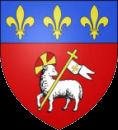 |
approximate
population : 111,805
average altitude/elevation : 15 m
- cathedral dimensions
- • exterior length: 144 m
• length, transept exterior: 57 m
• length, nave: 60 m
• width, western façade: 61.60 m
• width, nave: 24.20 m
• height, central aisle vaulting: 28 m
|
Also about the city of Rouen:
the 6th bridge at Rouen: Pont Gustave Flaubert, new vertical lift bridge 
end notes
- There are free shows, lighting
up the Cathedral from early June to late September every year.
June, July: from 23:00/11pm
August: from 22:30/10.30pm
September: from 22:00/10pm
Further information is available from the Rouen Tourist Office: 02.32.08.32.40.
- See also the references to Bourges
in Gothic
cathedral and church construction.
- The French word is hospitalier.
This word can have several meanings.
As an adjective [describing word] it can mean of a hostipal, or hospitable
(welcoming), or charitable.
As a noun [naming word], one meaning is a founder or worker in a hospital
- a place where people are made welcome and cared for. Another meaning
is a member of a charitable order, particularly one associated with
medical care such as the order of St. John. In the UK, there is a derivative
called the St. Johns Ambulance Brigade, whose members provide primary
first aid at public events.
- Flaubert’s La Légende de Saint Julien l'Hospitalier available
in French in two parts:
part
1 part
2
A
translation into English of the Legend of St. Julian the Hospitaller.
- The Tour Beurre, or Butter
Tower, was so named because it was believed that the tower’s construction
was paid for out of the dispensations granted to those who did not wish
to fast during Lent. As part of the dispensation, these people were
allowed to drink milk and eat butter.
The Butter Tower contains fifty-six bells.
- The central lantern
tower, combined with its spire, is the tallest in France at 151m or
495 ft. Building started in the thirteenth century, the spire being
raised in the sixteenth century. The present cast iron spire was raised
in 1876 to replace the previous wooden spire, covered in gilded lead,
which had been placed there in 1544.
From Rouen,
It’s [sic] History and Monuments, A Guide to Strangers by Théodore Licquet, 1847, reprint 2007
“We cannot give too many praises to the zeal of M. de Vansay,
prefect of the department at that time: the misfortune happened
on the 15th september, and already on the 26th of the same month,
the government having been informed and solicited by that magistrate,
ordered M. Alavoine, one of the best architects, to go to Rouen,
and confer with the prefect on the means of remedying the havoc
caused by the fire. Early in the year 1823, the roofs of a aisles
had already been repaired; and a portion of the nave had been covered
with lead, by the 15th march of the same year. The roofs of the
choir and of the whole transept, were also soon repaired; but, for
these parts, a copper covering was preferred as being more solid
and less liable to be destroyed. The raising and renewing the lantern
was terminated in 1829.
“From this new platform, the pyramid will rise majestically
in the air, and of it we already discover thirteen floors (the pyramid
will be completed with one more), each of four metres fifty centimetres,
that is to say a height of fifty eight metres, or about one hundred
and eighty feet. The spire of the church was first erected of stone
but was overthrown by the electric fluid, after that, it was twice
built of wood, and both times it became the prey of the flames;
to rebuild it with wood would have been gathering materials for
a third fire, but now it is made of cast iron and in open work.
At the summit of the spire, there will be a small lantern surrounded
by a gallery for the purpose of meteorological observations. The
total weight of the spire when completed, will be 600,000 kilogrammes,
or about 1,200,000 pounds. It is composed of 2,540 pieces, not including
12,879 iron pins[13]. Lastly, this magnificent pyramid will reach
an elevation of 436 feet; that is to say 40 feet higher than the
former, and will only be 13 feet less than the highest pyramid of
Egypt[14].
“[Footnote 13: The whole of these pieces of iron were cast
at the foundery at Conches, a small town, which is situated at about
twelve leagues from Rouen, and the expense is valued at 500,000
francs.]
“[Footnote 14: For the description of the archbishop's palace,
see the chapter on the civil monuments.]”
The spire also has 812 steps inside it. These could
be climbed, if you have the nerve, but we are not sure whether this
is still permitted.
|
















